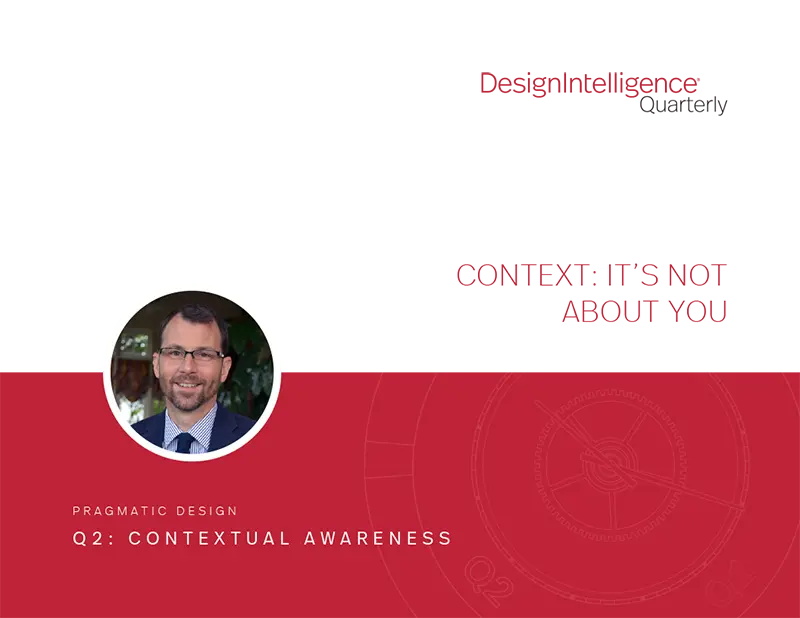Context: It’s Not About You
by Bob Fisher
Principal, DesignIntelligence
June 28, 2023
Smart firms are taking a new approach to connect with clients.
Architects and designers are attuned to context when they create. Their work incorporates layers like a site’s topography, immediate environment and history, local culture, weather patterns, social and political considerations, regulatory limitations, project economics and more. Over time, managing this sort of complexity becomes natural. Context is integrated into design practice.
Mastery of context is also valuable in running a design enterprise. Complex factors like talent, finances, operations, marketing, leadership and culture make up the context of a professional practice. Understanding how to integrate them is essential to building a great firm. Many leaders in architecture and design get this idea, and you see it in healthy, well-run firms.
In the past decade of working with professional practices, I have seen one area where plenty of firms still struggle with context. It’s in connecting what they do to the needs of their markets, which is the foundation of how they position themselves and win work.
In the traditional approach, firms frame their understanding of the client’s world through the lens of architecture and design. They focus on the object – buildings, interior spaces and designed outdoor environments. Not that the client and their goals and challenges are ignored. Such firms simply see the client’s world through their own context, and it is reflected in their marketing communications and how they talk about their work.
Some hallmarks of the traditional approach:
- Explaining the fundamental client need through what the firm provides, e.g., saying they came to the firm for a new surgery center, dormitory or corporate headquarters.
- Talking first about design features and client concerns as rationale for design decisions.
- Emphasizing statistics like total square footage and construction budget.
- Showcasing beauty-shot photos of the building, rooms and exterior environments that are devoid of people, except when included for scale.
- Using architecture and design jargon to talk about projects and the firm’s philosophy or approach.
- Beginning most statements with “us” or “we.”
The underlying assumption in this traditional mindset is that clients award projects based primarily on the quality of the designed object or environment. The firm’s job is to explain itself clearly and present its work appealingly. In such a world, the firm that wins is the one that preens most effectively.

Ten years ago, when I focused my research and advisory work on the built environment industry, the traditional approach seemed to dominate. In the past several years, I’ve seen a better way become more prominent. Firms have begun to invert the frame. First, they demonstrate an understanding of the client’s context, then they present themselves and their work from within it.
Hallmarks of the client-first approach include:
- Articulating fundamental client needs through what matters most to them, e.g., their mission, business objectives and changes they wish to make in their organization.
- Presenting the firm’s work through the same lens of client mission, business objectives and desire for change.
- Placing the client at the center of the firm’s design process, i.e., articulating it through how the client will participate or contribute and what they will experience.
- Framing their marketing first on issues and topics that are relevant to the client, second on how built environments may help.
- Using clear and simple language.
- Beginning with the second person (“you”) in most cases; keeping the “conversation” focused on the client.
Most readers will see what I’ve written and think, “We’re already doing that.” In some cases, they are right; in many others, they only think they are. To test their approach, I ask them how they begin client interviews. Usually, they respond that they give an overview of the firm’s capabilities, relevant experience and successful projects, then knit all that together with what they believe the client needs and wants. Seems logical, but whether or not they are aware of it, they frame the discussion on themselves. It’s a safe bet that their web copy, cover letters for proposals and other marketing collateral take the same approach.
It is not that firms who tend toward the traditional approach ignore their clients. They usually care deeply and are dedicated to serving their clients well. The challenge is that they still think first of how they can help their clients, rather than beginning with their client’s context.
Clients see the world through their own context and that of their customers. They see your design firm through their own mission, goals, aspirations, limitations, challenges and pain points – and how well you can help them navigate that landscape.
Meet them where they are and you’ll earn their trust – and their work.
Bob Fisher is a principal with DesignIntelligence. In addition to a decade of focus on architecture, design, engineering and construction, he spent more than 20 years in brand, marketing and communications for the entertainment, education, technology and manufacturing sectors.


